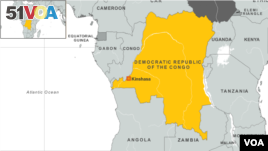November 18,2014
In the southeastern Democratic Republic of Congo, there is an area called the Triangle of Death. It’s located within Katanga Province where the U.N. says a humanitarian crisis has been growing worse since the end of 2012.
The U.N. refugee agency – UNHCR – said there are 600,000 displaced people in Katanga Province. That’s a result of ongoing fighting and violence. More than 70,000 were displaced in the last three months alone.
In Kinshasa, UNHCR spokesperson Celine Schmitt said the crisis in Katanga has not received as much media attention as conflicts in the northeastern Kivu provinces.

Democratic Republic of the Congo
“There are two conflicts ongoing in Katanga. There is an increase of violence by a militia group called the Mai Mai Bataka Katanga – attacking villages, attacking the population. But also there is a conflict between two groups – between the Luba and the Twa in the north of Katanga and [it’s] now turning into much more violence. Entire villages have been burned. People are being displaced and women have been raped,” she said.
The Mai Mai Bataka Katanga militia has been fighting the Congolese army. UNHCR says that conflict “reignited” in 2011 after the Mai Mai leader escaped from prison. The fighting between the Twa and Luba results from long standing tensions between the ethnic groups.
It’s happening in what’s called the Triangle of Death in northern Katanga. It consists of the three towns of Manono, Mitwaba and Pweto.
“Violence has been ongoing in this area. And the violence was so strong that the area has been called the Triangle of Death. Both conflicts are taking place in the Triangle of Death.”
Schmitt said that “sexual violence is a serious concern.”
“In the north of Katanga, our protection monitors for all our teams on the ground have recorded more than 1,500 cases of sexual violence since the beginning of this year. But we fear that many more cases remain unreported because we lack access to the area -- because of security reasons. But also because women are scared to report the rapes,” she said.
Few rape victims, she said, have access to health care or psycho-social support. When possible, rape survivors have been “referred” to UNHCR’s medical partners for treatment.
The U.N. agency and other aid groups are not able to reach many of those in need. Schmitt learned that first hand.
“I was myself in Katanga last week. I was in the triangle of Death to meet our partners there and to meet the victims. In order to go to some of the villages that have been burned we had to travel an entire day by road. Then we had to cross the Congo River. Then we had to take a speed boat. And after, more or less, six hours we finally arrived in the village,” she said.
One of the places she visited was the Mukondo site for the displaced. About 1,300 people live there. She said elders told her that 19 children have died there since March due to diarrhea, anemia and malaria.
The lack of access to troubled areas is due in part to safety concerns for humanitarian workers, as well as a lack of funding for aid work.
UNHCR is calling for an “increased presence of Congolese authorities” in the area. The agency also is working with the group Search for Common Ground to end the conflict between the Luba and Twa. That includes participatory theater and mobile cinemas to get the communities together and discuss issues.
UNHCR also said MONUSCO – the U.N. peacekeeping mission – should “reinforce its presence to better protect Katanga’s civilian population and prevent further human rights violations.”
In all, there are more than two-and-a-half-million displaced people in the DRC – the majority in North and South Kivu Provinces.